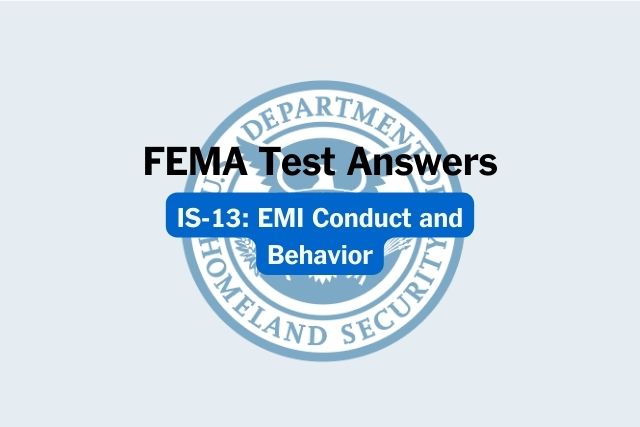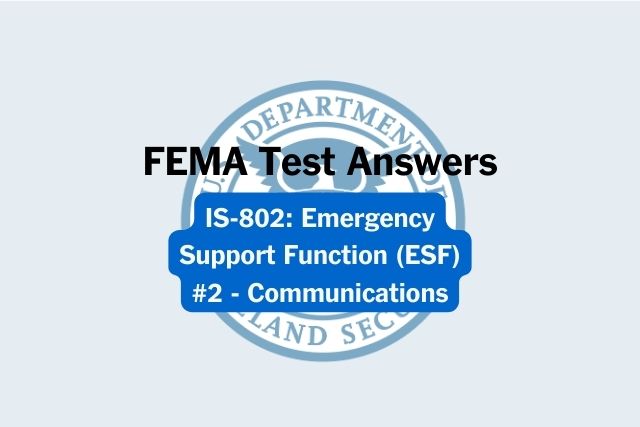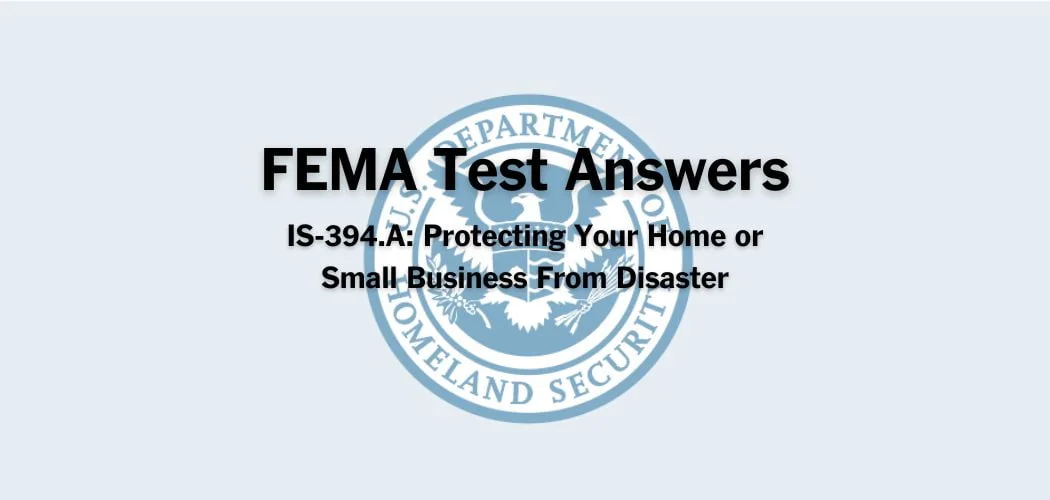Overview: FEMA IS-120.C course was published on 2/12/2018 to introduce the basics of emergency management exercises. It also builds a foundation for subsequent exercise courses, which provide the specifics of the Homeland Security Exercise and Evaluation Program (HSEEP).
Primary audience: The FEMA IS-120.C course is for emergency management and homeland security professionals who require an introduction to exercises. EM, PIO, Fire, EMS, PH, LE, PW, VOAD, Private Industry.
FEMA IS-120.C test answers
Each time this test is loaded, you will receive a unique set of questions and answers. The test questions are scrambled to protect the integrity of the exam.
Question 1. A Training and Exercise Plan (TEP) is developed through which type of exercise?
A. Full-scale exercise
B. Seminar
C. Workshop✅
D. Tabletop
Question 2. Through exercises, what can agencies determine about their resources?
A. Location and state of readiness
B. State of readiness and capabilities
C. Location and performance
D. Capabilities and performance✅
Question 3. Identify the ways in which an effective exercise program can help an organization.
A. Minimizing legal actions
B. Ensuring core capabilities are validated
C. Maximizing resources✅
D. A and B
E. B and C
F. All of the above
Question 4. What are the benefits of involving the whole community in exercise planning?
A. Additional funding available
B. Already aware of gaps in resources
C. Provide additional historical information
D. Fosters better coordination and working relationships✅
Question 5. Exercises can be used to:
A. Validate plans
B. Apply for funding
C. Get buy-in from elected and senior officials
D. Identify resource gaps
E. Identify venue discrepancies
F. A and D✅
Question 6. All of the following are included in an Improvement Plan (IP) except:
A. Updated Training and Exercise Plan (TEP)✅
B. Corrective actions
C. System for tracking corrective actions
D. Identification of corrective action owners and assignees
Question 7. When should the exercise planning team arrive for a discussion-based exercise?
A. Several hours before StartEx to prepare setup and registration
B. At StartEx There is a small team identified to handle registration
C. One day prior to arranging room furnishings, then return at StartEx✅
D. One hour before the start of the exercise (StartEx) for registration
Question 8. Under which mission area would these core capabilities fall: Cybersecurity, Supply chain integrity and security, and Access control and identity verification?
A. Response
B. Recovery
C. Protection✅
D. Prevention
E. Mitigation
Question 9. A trusted agent is an individual who maintains the integrity of the exercise by preserving confidentiality. Which member of the exercise planning team serves as the trusted agent?
A. Safety Officer
B. All members of the exercise planning team✅
C. Subject Matter Expert (SME)
D. Lead Exercise Planner
Question 10. Which discussion-based exercise type uses models or simulation?
A. Tabletop✅
B. Game
C. Drill
D. Workshop
Question 11. What concept does the following statement define? A focus on enabling the participation in national preparedness activities of a wider range of stakeholders from the Federal, State, local, tribal, and territorial government, the private and nonprofit sectors (including nongovernmental organizations), and the general public in order to foster better coordination and working relationships.
A. Whole Community✅
B. National Preparedness System
C. National Incident Management System (NIMS)
D. National Preparedness Goal
Question 12. Complete the sentence: Discussion-based exercises _______, whereas, operations-based exercises _______.
A. validate plans, policies, agreements, and procedures; familiarize participants with plans, policies, agreements, and procedures
B. involve deployment of resources and personnel; do not involve deployment of resources and personnel
C. include tabletop exercises and games; include drills and functional exercises✅
D. do not involve deployment of resources and personnel; involve deployment of resources and personnel
Question 13. Which type of operations-based exercise incorporates the mobilization of units, personnel, and equipment?
A. Drills
B. Functional exercise
C. Full-scale exercise✅
D. A and B
E. A and C
Question 14. What are the types of interactions that occur during a discussion-based exercise?
A. Facilitated discussion, multimedia presentation, contingency process, and exercise data collection
B. Facilitated discussion, multimedia presentation, moderated discussion, and contingency process
C. Facilitated discussion, multimedia presentation, and moderated discussion
D. Facilitated discussion, multimedia presentation, moderated discussion, and exercise data collection✅
Question 15. A component of developing and executing an exercise program is:
A. Master Scenario Events List (MESL)
B. A multi-year Training and Exercise Program (TEP)✅
C. Situation Manual (SitMan)
D. Master task list
Question 16. An effective exercise program can help an organization:
A. Maximize efficiency and resources
B. Meet their program priorities
C. Maximize time and funding
D. A and B
E. A and C
F. All of the above✅
Question 17. Early engagement with elected/appointed officials is the key to success.
A. TRUE✅
B. FALSE
Question 18. Operations-based exercises are used to:
A. Develop new plans, policies, agreements, and procedures
B. Generate in-depth discussion and problem solving
C. Practice and maintain current skills✅
D. Familiarize participants with current plans and policies
Question 19. The required subject matter expertise or background for an evaluator is documented in the exercise evaluation plan.
A. TRUE✅
B. FALSE
Question 20. Which type of discussion-based exercise produces a product?
A. Game
B. Tabletop
C. Workshop✅
D. Seminar
Other popular FEMA test answers
- IS-005: An Introduction to Hazardous Materials
- IS-010: Animals in Disasters: Awareness and Preparedness
- IS-100: An Introduction to the Incident Command System (ICS)
- IS-230: Fundamentals of Emergency Management
- IS-235: Emergency Planning
- IS-244: Developing and Managing Volunteers
- IS-363: Introduction to Emergency Management for Higher Education
- IS-700: An Introduction to the National Incident Management System
- IS-906: Workplace Security Awareness
- IS-907: Active Shooter: What You Can Do
- IS-909: Community Preparedness: Implementing Simple Activities for Everyone



